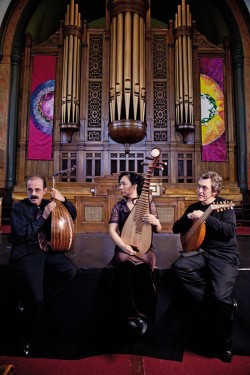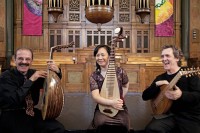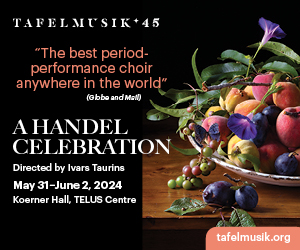 The first couple of rows of the sanctuary floor at Trinity-St. Paul’s United Church are rather busy for a Monday when none of its major musical tenants (Tafelmusik, Toronto Consort, Talisker Players), is rehearsing. I am sitting in the front row, firing questions at Bassam Bishara, Wen Zhao and Terry McKenna who are perched at stage edge, instruments in hand. WholeNote webmaster Bryson Winchester, doubling as videographer for the day, is one row behind me, taking notes on what it will take to immortalize my interviewing brilliance. And in the midst of it all, WholeNote cover photographer Air’leth Aodhfin is quietly going about his business, snapping photos.
The first couple of rows of the sanctuary floor at Trinity-St. Paul’s United Church are rather busy for a Monday when none of its major musical tenants (Tafelmusik, Toronto Consort, Talisker Players), is rehearsing. I am sitting in the front row, firing questions at Bassam Bishara, Wen Zhao and Terry McKenna who are perched at stage edge, instruments in hand. WholeNote webmaster Bryson Winchester, doubling as videographer for the day, is one row behind me, taking notes on what it will take to immortalize my interviewing brilliance. And in the midst of it all, WholeNote cover photographer Air’leth Aodhfin is quietly going about his business, snapping photos.
“How about the pipa in the middle and the two gentlemen on either side,” suggests lutenist McKenna.
“For what it is worth, for the concert [Toronto Consort’s Lutefest, May 7 and 8] I think I will be staging it so that Bassam is in the middle, Terry is to his right and Wen is to his left.” (The voice comes from behind me, about four rows back. It’s Toronto Consort artistic director David Fallis, keeping a careful eye and ear on the proceedings.) “That way the oud, which is the instrument from which the other two descended, is in the middle, at the centre of the Silk Road, so to speak, with its offspring on either side – the lute to the west, the pipa to the east.”
Offspring? Oops. I’ve already called the instruments siblings on the cover of The WholeNote. (And the Toronto Consort’s own press release calls them cousins.) Oh well never mind. If Wagner can do it, so can we.
“They [Bassam, Terry, and Wen] each chose a master composer/player,” Fallis explains. “Bassam’s chosen master is Ali ibn Nafi, known as Ziryab, who founded a school in Andalusia – in Cordoba – in the 9th century. Wen chose a woman pipa player from around the 12th century, Li Gong Ren, who was the favourite of the Yuan dynasty emperor of the time. And Terry has chosen Francesco da Milano, one of the first really great European lutenists. Da Milano, from the 16th century, dropped the pick and used fingers, which enabled the lute to play polyphony. Because that’s another point that we will make, that these instruments have common roots but they have gone quite distinctive paths. The oud without frets can do all the quarter tones, and the pipa has this special technique with the wheel and picks and so on, and the European lute decided to go polyphonic, something unique to Western music.”
“So these three masters will be the focus of the first half, as presented by each of our featured players in turn. And then after the three ‘masterclasses,’ so to speak, they will play one piece together. And that will be the first half. And then in the second half we try to talk about common themes. So there are groups of pieces, with something for each instrument. There will be a group that has to do with night, and a group that has to do with birds, and groups of pieces, in every one of the cultures, that have to do with the instrument itself.”
There is some gentle ribbing from the stage (“Now he tells us!”) as Fallis explains, for The WholeNote’s benefit, how the performance will unfold. Strange as it seems to me – the performance is mere weeks away – rehearsals are not yet under way. But these are professional musicians, accustomed to being able to concentrate fully on each thing in its turn, and this one is, relatively speaking, still a way down the road. Bassam Bishara, for example, has two other projects to deal with first. “My Coptic hymns concert is April 23,” he says, “at St. Mary and St. Joseph Coptic Orthodox Church in Richmond Hill. It is about the melody of old Coptic hymns arranged in a new orchestration and choral arrangement, and accompanied by 10 musicians: double bass, cello, viola, four violins, nay, and qanoun. On April 24, the next day, I have a performance with Arabesque Dance Company at Ryerson Theatre at 8:00pm. It is the Annual International Dance Conference.” He also has a possible gig with world-music band Sultans of String coming up in May, but the details of that are even fuzzier than the Toronto Consort performance.
Bassam Bishara, for example, has two other projects to deal with first. “My Coptic hymns concert is April 23,” he says, “at St. Mary and St. Joseph Coptic Orthodox Church in Richmond Hill. It is about the melody of old Coptic hymns arranged in a new orchestration and choral arrangement, and accompanied by 10 musicians: double bass, cello, viola, four violins, nay, and qanoun. On April 24, the next day, I have a performance with Arabesque Dance Company at Ryerson Theatre at 8:00pm. It is the Annual International Dance Conference.” He also has a possible gig with world-music band Sultans of String coming up in May, but the details of that are even fuzzier than the Toronto Consort performance.
Terry McKenna is not to be outdone. “Between now and the TC Lutefest, I will be heavily engaged at the Stratford Festival playing lute and various guitars for Kiss Me Kate and Evita. I am also contributing to a fundraiser for the Grand River Baroque Featival on Sunday May 3 in the town of Ayre. Further, I am busy in my role as music director for my wife’s theatre school, Playmakers! (www.play.makers.ca) Their productions of As You Like It and Much Ado About Nothing happen the same weekend as Lutefest.”
And the pace continues after Lutefest. “May 16 I am playing an all-Corelli programme with Folia, the Kitchener-Waterloo based ensemble led by Linda Melsted, and then Linda and I have a fun programme of Baroque, Romantic and Modern rep for violins and guitars which we will present on July 15 at Tamara Bernstein’s Music Garden series. Then [Toronto Consort colleague] Laura Pudwell and I will tour Nova Scotia in August with ‘Laura Pudwell’s Historical Romance.’ And, immediately after, the Toronto Consort will join us for a Nova Scotian revival of our ‘Milkmaids and Mariners’ programme.”
Of the three, Wen Zhao seems to have her sights most squarely set on the upcoming Consort performance. “I am practising for the Lutefest concert now,” she says. “I hope my audience will hear the difference between my solos in this project and those from the Marco Polo Project with the Toronto Consort from a year ago.” In the fall she will renew her association with Trinity-St. Paul’s other early music specialists, Tafelmusik, for a tour of last year’s “Galileo Project.” “It will be my great honour to work with Tafelmusik again for the Galileo Project, touring in Asia in October. This will be my second Asia tour with them. The first time was the Four Seasons project in 2007. I can’t wait to perform in my hometown, Beijing.”
All three of the projects she mentions (Galileo, Marco Polo, and Lutefest), have a certain curatorial style in common. At Toronto Consort it is David Fallis’s trademark; at Tafelmusik it is bassist Alison MacKay’s. (That she and Fallis are a “real life” couple doesn’t hurt.) It is the ability to home in on a moment when histories converge, and then illuminate those moments in all their inter- and cross-cultural diversity.
The relationship between oud, pipa and lute presents one such opportunity for illumination.
“Oud means wood in Arabic,” Bassam Bishara explains, “and except for the decoration this instrument is fundamentally the same as it was as far back as around 600 in Iraq and Syria.” There is evidence of the oud’s journey east along the Silk Road dating at least that far back. On its arrival, it impacted on the evolution of Chinese stringed instruments, with a lineage going back a thousand years earlier than that. In fact the relationship could better be described as a series of convergences over centuries.
In the case of the oud’s journey west, Ziryab’s 9th-century journey to Andalusia was the key. “He was the master of the first three musical schools in Spain,” Bassam explains, “for oud and singers. This was the most complex poetry in all the Arab world. His audience would have been both Europeans and Arabs, and the contexts for performance would have been primarily entertainment and ceremonial.” In the evolution of the word “oud” to the word “l’oud” (or “lotto” in Italian), the genesis of the lute can be seen.
“You have to remember” McKenna says, “they were very formal then – rules of war, and all that. It’s not far-fetched to imagine opposing generals (and therefore their musicians) meeting before battle for dinner. And then, after a tough day of slaughtering people, you’d want to go back to your tent and hear some lute music.”
Wen Zhao agrees. “For my master, Li Gong Ren, too, the audience was high class, courtly. She was in fact not allowed to play anywhere except the Forbidden City, for the emperor and whom he chose. She lived in his house her whole life. And played every day, for rituals, ceremony, entertainment.”
“It was the same for my guy, da Milano, too” McKenna says. “I mean, face it, musicians go where the money is, then as now, so that would have been in aristocratic circles. Francesco da Milano was in the service of the pope at the time and travelled with his entourage. There are famous letters from the time – somebody writing about an entertainment and saying ‘and then, to top it off, da Milano came to entertain, and we were transported by this playing.’ They didn’t call him ‘Il Divino’ for nothing, and it was a title conferred only on a few. It’s really interesting how documents like these shed a bit of light on how to interprete the music. We have no verbal guidance, so you look for all kinds of clues through written accounts and paintings.”
Today we often come to music with the sense that composer and performer are at different ends of a professionalized spectrum. Not so for our three masters. “As for Bach, the working musician, part of being a master musician was, metaphorically, being able to show up at the palace at 4:30pm, with something to play,” McKenna says. “So better write it yourself.” Putting differences of centuries, modes, instruments, cultures aside, all of these masters could do just that. “It’s all very practical when you strip it away.”
Just as interesting as the evolution of the instruments and the music written for them is the evolution of the systems of notation that evolved in order to hand the music down. In the case of the pipa a lot of it was oral, passed from teacher to student, until the 17th century at which time notation based on Chinese calligraphy was employed, followed, in the middle of the last century, with a notation based on seven numbers. In the case of the lute, early on a system of tabulature, eerily similar to the “tabs” favoured by many young rock musicians today. And in the case of the oud, the system was based on numbers for the fingers, and their position on the fingerboard.
At the end of the day, it was a successful shoot/interview. It’s always most fun at The WholeNote when a cover photo weaves together such disparate threads – revealing a bit more about the shade of each by bringing them into unexpected juxtaposition. Toronto Consort’s David Fallis has the trick of illuminating juxtaposition down to a fine art, as the “siblings” at Lutefest, May 7 and 8 should, once again, reveal.
David Perlman, The WholeNote’s Publisher, is occasionally pressed into service as a feature writer. His more usual perch can be read here.



